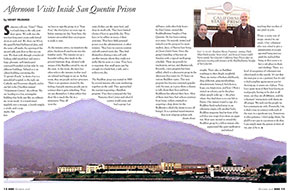Henry Frummer
Works
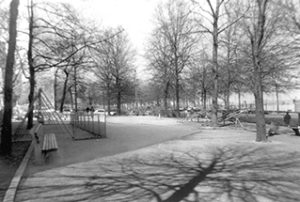
Growing Up in the Bronx
Growing Up in the Bronx
by Henry Frummer
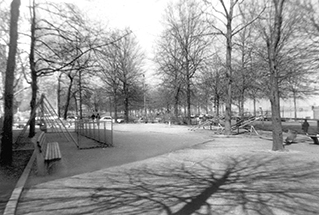
First Park
I grew up in a very pleasant neighborhood in the northwest Bronx called Kingsbridge Heights. Aptly named, it is situated on the high ground overlooking the once strategic King’s Bridge that connected Manhattan to the mainland. I did not grow up in just any Bronx; I grew up in THE Bronx. Oddly enough, two historical figures would influence my experience of
growing up by creating a unique Bronx geography.
New York City is a city of immigrants. My neighborhood was made up of mostly Jewish, Italian, and Irish of the second generation. But it seemed to me like the world was inhabited mostly by Jews. The people in my building, my intimate community, were mostly all Jews. When I went to public school, it felt that we were not a minority group at all. The teachers were Jewish and perhaps one kid per class of 32 was not. Parochial school got all of the Catholic kids. Heck, our schools were even closed on the Jewish holidays. Despite the fact that it was a happy neighborhood, there was an uneasiness hanging over it. We lived in the shadow of the Holocaust. It was a recent memory for our parents, especially our fathers, who all fought in the war. We lived side by side with camp survivors. One of my neighbors living on our floor had blue numbers on her arm. I noticed it while were we watching her TV and asked my mother about it. From an early age, I had to come to grips with the events that took place six years before my birth. That neighbor had an early TV with a tiny screen perhaps a couple of inches tall. In front of it was a large magnifying glass; even King Kong looked tiny on it.
Perhaps that was one of the beauties of New York. Each minority would self-segregate until the area felt like home. Little Italy in the Bronx (portrayed in Green Book) felt like another world, with hams unaccountably hanging from the ceilings of the shops and Italian spoken on the street. This kind of unique ethnic character was duplicated all over the city. It was a melting pot where the flavors remained distinct. When I was older, I explored these places as if traveling the world, with its sights and sounds and food, especially the street food on pushcarts. It was a world filled with clichés. Walking along my local shopping street, there was an Italian pizza place, an Irish bar, a Chinese laundry, a kosher deli and a kosher butcher, and a Chinese restaurant (yes, where we ate Christmas dinner), all of which were manned by their respective ethnic group. There were also the ubiquitous diners with their oddly large and varied menus, for some reason always run by Greeks. We knew the owners’ names, and they knew ours or at least knew us by sight. I realize as I write this that they watched us grow up and steadily be replaced by new faces.
The center of our shopping universe was the candy store, which sold a bit of everything. This is where we got our, well, candy, but also pretzels, ice cream, magazines, and baseball cards. It had a lunch counter and a soda fountain where you could get hamburgers and milk shakes. It was not glitzy like an ice cream parlor or sterile like today’s 7-Eleven. It was more like home with lots of wooden fixtures and inviting smells. I can’t imagine people getting all misty-eyed thinking about their local convenience store, but people feel that way about their local candy store.
It was a lower-middle-class area. Few luxuries but even fewer wants. We all wore hand-me-downs, and the purchase of a new car was a rare event. But the food was plentiful and the escape to summer camp or bungalow colony in the summer was common. There were those breezeless sultry summer nights when it never cooled down and you slept only on bottom sheets while the sounds of the street wandered through the open windows. There was little “keeping up with the Joneses,” perhaps because you would have to look far and wide to actually find one.
Even though it was New York City, my area was not a concrete jungle -— no dreary and uniform block after block of apartment buildings that is so common in New York. My apartment building had a park right next to it, and there was a series of parks one block from each other. Once we could cross the street alone, the possibilities were seemingly endless, as each park had a distinct character. First Park (its actual name) was next to where I lived and had a playground with swings and monkey bars. Second Park was where we sledded and held snowball fights. One of my fondest memories was a mass snowball fight there with at least 20 kids per side, an early form of paintball, if you will. Third Park held the challenging rocks to climb, for a six-year-old, that is. Fourth Park had a plaque mentioning the old Fort Number Four. There were other parks, but these were ones we played in. I have George Washington to thank for all of it. He built a series of forts, including nearby Fort Independence, to try to stop the British after he evacuated Manhattan. Several delaying actions were fought in the Bronx before Washington had to retreat from there as well, leaving behind some nice parks for me to play in.
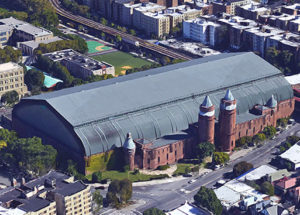
The Armory
But the person who transformed the geography of my neighborhood most dramatically was Winston Churchill’s grandfather. He built a racetrack in 1866 that was located directly across the street from where my apartment building was to stand. It was quite successful and brought many innovations to the racing world, and when it eventually closed the city decided to build a reservoir on half of the site, and on the other half they built three large high schools, one public school, one college, and a massive Armory.
From an early age I was surrounded by kids my age. Being in the middle of the Baby Boom, about eight of us of the same age in my building grew up together. We were pushed side by side in our strollers and ended up going to college together. Moving away was rare, and I lived in this building for the first 22 years of my life. I was molded by this kind of stability, and so in later life, during my 41 years in California, I have had only two addresses.
When in school we wore shoes that we periodically brought to the shoemaker for heels and soles, but in the playground we all wore black Converse High Tops. We played cowboys and Indians like the rest of 1950s America. Coonskin caps were the rage; thank you, Davy Crockett. We did the fad of the day whether it was spinning tops or playing with yo-yos, each trying to be the best. There was stickball, played with a broom handle and pink Spaldeen ball. There were so many parks and schoolyards around that I never played in the streets like many kids did. We played “Scully” with bottle caps or marbles, trying to “get all the marbles,” and the always popular indoor sport, baseball card flipping. The game I loved the best was tackle football in the snow. My low center of gravity really came in handy. Often we were off on long walks; from an early age we were told to go and play outside and not to come up until 6 pm, when dinner would be on the table. We had a great deal of freedom at an early age.
New Yorkers are big walkers. We were rarely driven anywhere except for family outings. The subway was a third of a mile away. The main shopping area, Fordham Road, was three-quarters of a mile away. Our favorite walk was the two miles to Van Cortland Park at the north edge of the Bronx, if for no other reason than to eat at the White Castle nearby. It is only now that I am puzzled by the fact that we did not go to the Bronx Zoo, which was the same distance. By 12 years old I was riding the subways alone. This opened all of Manhattan to me, including going to Central Park where the Metropolitan Museum of Art and the Museum of Natural History were located. The subways were cheap, and the museums were free. When I was in high school Saturdays were often spent exploring the city. I loved to visit the museum called the Cloisters in the very northern end of Manhattan, where I spent time in my brooding teenage years looking at Medieval art and listening to piped-in Gregorian chants. It was filled with cloisters from Europe that Rockefeller brought back brick by brick, situated on a high bluff with views of the Hudson River. It was a two-plus-mile walk from my house, but the tough part was going from Kingsbridge Heights down to the East River and up to the even higher Washington Heights. The famous Bronx stairs in Joker will give you an idea of those long stairways down to the river. My friends were not nearly as museum crazy as I was, and I preferred going alone anyway.
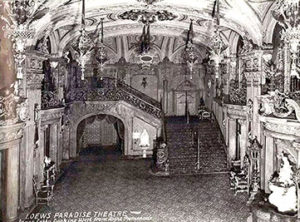
Loew’s Paradise Theatre
The intersection of Fordham Road and Grand Concourse was one of the great shopping centers of the Bronx. It was anchored by the, huge for its day, department store, Alexander’s. The area contained all sorts of stores, from fancy ice cream parlors to upscale shoe stores. It was also where several movie theaters were located. Built in the ’30s when going to the movies was a fancy experience, they were grand theaters, and the grandest of them all was Loew’s Paradise, which resembled a European opera house more than a place where movies were shown. Its furnishings were dazzling. Even during a movie, I would gaze at the starry ceiling and the ornate gold carvings that entirely covered the inside. It was a time of double features. What I find puzzling now is that we did not try and catch the beginning of the movies but showed up whenever we wanted. Then at a certain point we would say, “This is where we came in,” and leave. I would never think of doing that now.
Our mothers did not work outside the home, so a home-cooked meal was standard and became a time for the family to get together. We never watched TV while eating. We kept multiple conversations going at once, each of us jumping in whenever we wanted. This kept accelerating until my mother in exasperation told us that we had to limit the number of simultaneous conversations to the number of people at the table. There is a scene in Woody Allen’s Annie Hall that captured the spirit of our dinner table. There was no smoking among the parents and very little drinking; consequently, my friends and I did not smoke or indulge in teenage drinking.
We all went to Hebrew School at the orthodox synagogue, which was always referred to as the Shul (meaning school), after public school to prepare for our bar mitzvahs at age 13. We learned Hebrew and Jewish history. None of us kids went to the Shul for services. It was not the center of our community like a church would be. The families were culturally Jewish but few were observant Jews. No one kept kosher, but Jewish food (a variation on Polish cooking) was constantly on offer. Passover was the big holiday of the year, commemorating the flight out of Egypt. It is a long ritual meal that our family only occasionally did. But it was a time for relations to get together and have a big feast. Hanukkah was a minor holiday that no one made a big deal over. One of my friends had a Hanukkah bush, which was a small tabletop version of a Christmas tree. We all laughed at him for it. On the high holy days, some of the parents went to temple, but mostly people just dressed up and hung out in front of the building. I was always asked where my father was but had no real response, as he was always sitting home in his shorts watching a Yankees game. I just pleaded ignorance.
Apartment life had its advantages for us kids. When it was raining or snowing, all we had to do was get on the elevator and visit our friends. We were often in each other’s houses, and everyone’s parents seemed to tolerate whatever ruckus we made. I think we all knew each other for so long that we all got along well. I can’t remember any serious problems among us. We never had fights, and I would joke that we would argue until one of us went home crying. Perhaps our values were just too similar. I was very bonded with them, so when we started half-day kindergarten and I was in the morning session and they the afternoon, it was a difficult time for me waiting until 3 pm, when I would hear them playing in the park under my window. Rushing out to join them, I was happy again. The apartment basement was filled with mysteries and dark, spooky corners. It was poorly lit, filled with noisy machinery. I had to walk the length of it to get to the basement elevator, avoiding the dark corridors leading off in other directions. It was a long time before I totally lost my nervousness about that walk. So you can imagine that we never played there, but it was the entranceway to the narrow alleys that ran along the buildings like a maze, a maze we knew very well. They were our own secret passages; at least in our minds they were secret.
Because of the unusual geography, it was as if I lived on a lake with parks around it. I walked to my public school, my junior high school (other side of the reservoir), my high school, and, yes, even my college while living at home. Most of my friends accompanied me through all of these schools. We liked school. We all knew somehow that we were going to college eventually, and grammar school was just one step toward that goal. Our parents didn’t talk to us about college, much like they did not talk about the sun rising the next day. It was all understood. I look at the early class pictures and see the future doctors and lawyers of America. I, the underachiever, became merely a chemist. My father wanted me to become an accountant like him. I guess this idea of a son going into the father’s profession was still around in the ’50s. Because everyone had a good idea of why they were in school, we were well behaved in class despite the fact we could not resist giving a substitute teacher a bit of a hard time. I went through school without anybody being bullied. I used to joke that the jocks in my high school were on the math team. There was no crime either. I have always been confused about the portrayal of city high schools in movies. One reason my experience was different is that I went to one of the specialized high schools that required an exam to get in. One would guess that the massive DeWitt Clinton HS that we could see from our school window had a different atmosphere. It was in high school that I finally met kids from all over the city. It was quite ethnically diverse. I was stunned to hear about what it was like to go to parochial school. They didn’t seem to enjoy the experience.
So I finally learned that NYC was not a Jewish city but mostly a Catholic one. I came to realize why Saint Patrick’s Day and Columbus Day were so huge. Going to Little Italy in Manhattan for a feast day was a scene straight out of The Godfather. It is sad for me that this iconic neighborhood is disappearing, being absorbed into Chinatown.
In an age when technological innovations were rare, two inventions changed our lives. The first was the ballpoint pen. Unused inkwells still garnished our school desks even after the advent of cartridge fountain pens. For the less handy of us, these latter could create quite a mess. When the BIC pen became available in 1958, we all switched, as they were so much easier to use. Nevertheless, because the early ones tended to leak, one could count on a favorite shirt eventually being ruined. The other invention that changed our lives was the portable transistor radio. It was the internet of our time. Music was marketed directly to us. We could listen to our music whenever we wanted to outside. Playing our 45s indoors might sometimes be a problem, but in the park we could always listen to our radios.
Then there were the Yankees. From our birth, their legends were told. Babe Ruth, Lou Gehrig, and Murderers’ Row were our mythic heroes. Stand aside, Zeus and Athena; the Yankees were in town, just a short subway ride away. Not only did we have the heroes of the past, we also had our own, in the form of Mickey Mantle, Roger Maris, Yogi Berra, and many others. We had hundreds of sacred images of these men, that we solemnly traded. The pantheon was led by the inscrutable but wise Casey Stengel. The World Series was our holy week. We did not keep Kosher, but we kept Yankees.
My story is a very Jewish version of the North Bronx. I have seen other stories that tell Italian and Irish versions. These wax just as poetic as mine but with more Jesus and less matzo ball soup. By all the accounts on Facebook at least, the Bronx was a wonderful place to live in the ’50s and ’60s. On my visits back recently, it seems to be that again. Probably various aspects of my experience growing up would be familiar to many in my generation, no matter where you lived in America. ■
